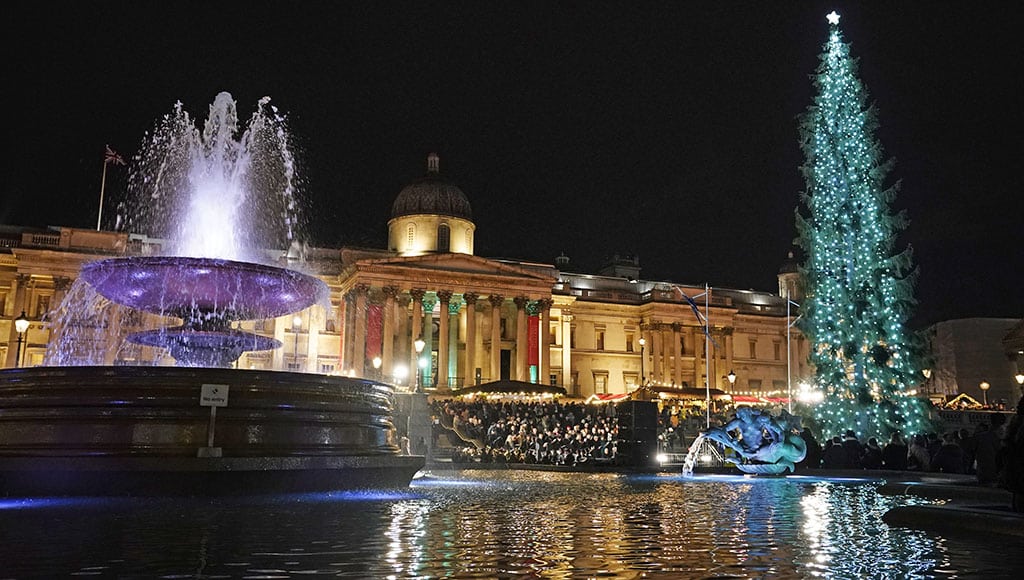Once again, we have called on our very popular contributor, COLIN BAINBRIDGE, this month to give his special twist on a London Christmas.
Medieval Festive MerryMaking!
Christmas was one of the highlights on the medieval calendar, not only for the rich but also for the peasantry. Some of the medieval traditions are still practised today in some form, some are not.
Ice skating in the capital was a popular Christmas activity even in medieval times. The marshes to the north of the city at Moorfields froze over and the 12th century writer William Fitzstephen describes how people would tie bone skates to their feet and shoot along the ice ‘as swift as a bird’.
In some years, the Thames froze over (24 times between 1400 and 1835) and allowed skating and frost fairs to take place. One of the main reasons for this is that the London Bridge completed in 1209 had 20 narrow arches that slowed down the flow of water, making it much more likely to freeze over.
A new London Bridge was opened in 1831, and the old bridge demolished. The arches were wider, so the Thames never froze over to the same extent again and frost fairs were no more.
One of the more bizarre festivities, no longer performed today, was the tradition of ‘Boy Bishops’. On St Nicholas Day (December 6), a boy would be chosen from the choirboys and declared a Bishop until December 28. He wore child-sized Bishop’s vestments and, rather cruelly, people were invited to playfully hit him in a practice known as ‘bash the Bishop’. Boy Bishops were finally outlawed by Elizabeth I.
A tradition that has some familiarities to us today was wassailing. The ‘wassailers’ would go from house to house singing and handing out wine or ale in return for food or money. If they thought they had been short changed, they would leave a dead mouse or rat on the doorstep. If the homeowner refused to deal at all, larger dead animals were left, such as foxes or, in some cases, diseased horses.
For Christmas dinner, goose was the most popular option (Turkey wouldn’t make to these shores until after the discovery of the Americas). The wealthy would often have venison. Poorer people would eat the parts of the deer which the rich people didn’t want. Offal was known as ‘umbles’ and, to make it go further, it was mixed with other ingredients and made into a pie. It was a case of the poor eating ‘umble pie’, which is where the phrase ‘to eat humble pie’ comes from.
Boxing Day in medieval times was a day where the rich would give the poor gifts of money in small clay pots known as piggies. Thus, the first piggy banks were invented.
The first day of the new year saw a tradition known as ‘detritus’ where people would urinate en-masse in the street. Supposedly it was to flush out all the negative events of the previous year. One tradition I suppose is still practiced today on January 1.
Oh Christmas Tree!
One of the annual festive favourites in the capital is the huge Christmas tree in Trafalgar Square. Traditionally, it is between 20 and 30 metres high. It has been gifted from Norway every December since 1947 as a thank you to Great Britain for being such a close ally during the Second World War. During Norway’s occupation, London provided sanctuary to the Norwegian king and government.
The spruce is selected from a list of candidates from the forest surrounding Oslo by a child whose Christian name starts with the letter ‘F’. The tradition goes back to 1947 when that first ever tree was picked by the head foresters’ daughter Freya.
Sadly, there are rumours that this could be the last year a tree will be given. The new City council in Oslo are going to evaluate whether the tradition is environmentally unfriendly and outdated.
It’s a Cracker!
If you happen to walk through Finsbury square in the borough of Islington, take some time to look at the drinking fountain.
Erected in 1899, it has a very festive connection. The inscription reveals it was commissioned and paid for by Thomas and Walter Smith to commemorate the life of their mother Martha Smith.
The sons had become wealthy when they inherited their father’s company. It is their father Tom Smith who is credited with inventing the Christmas cracker in 1847. He was a baker and confectioner who brought the French idea of having a bon-bon on the dinner table to London. He gradually improved upon the idea by adding toys and trinkets and making it so the wrapper could be pulled apart.
In 1860, he added the already commercially available bang and sold them under the name of ‘Bangs of Expectation’. To begin with, they were known as ‘cosaques’, supposedly because the bang was reminiscent of whipcrack from Russian horsemen. Later, when his son Walter came up with the idea of adding a paper hat, the Christmas cracker as we know it was born. In modern times, although ownership of the company has changed hands several times, you can still buy Tom Smith Christmas crackers.
The Great Elf Riot 1931
We can’t finish an article of London’s Christmas festivities without a mention of the largely forgotten elf riot of 1931.
The London toy store Hamleys had always had a Christmas parade as far back as the early 1900s. Like most stores in the 1920s, it suffered financial losses and, in 1931, had to shut down before being bought and reopened the following year.
Since there would be no parade that year, local businessman Herbert Smethhurst saw the opportunity to hold his own parade to advertise his grocery business.
Bizarrely, the parade was to comprise entirely of elves with a strict maximum height limit – Smethhurst himself wasn’t very tall. All was well for the first few streets, with large crowds in attendance. However, much to the annoyance of the official elves, the event was gatecrashed by a large number of over-height unofficial elves.
An argument ensued which developed into a fight and then what can only be described as a riot when the police intervened. A number of people had to be taken to hospital, others were arrested and taken to Leman police station. And that was the last of the elf parade.
London Calling wishes all readers a very Merry Christmas and a Happy New Year.
Richard Lamberth, who regularly writes London Calling, is away this month. He leads parallel lives with homes and business interests in London and Portugal. He provides consultancy services to leading businesses in insurance and financial services, property and media sectors. He has four sons, two dogs and enjoys a busy family life. He likes swimming, keeping fit and an outdoor life.
LondonCalling@portugalresident.com




















